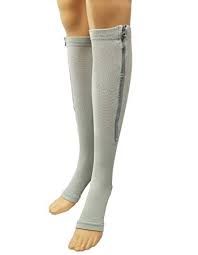
Compression socks have been around for a long time and have helped many people with venous disorders. Unfortunately, these socks can be quite difficult to put on and take off, preventing many people from using them and experiencing their benefits.
Many individuals with limited arm strength and those who have difficulty leaning over become annoyed and discouraged when they try to use compression gear.
Luckily, old technology and modern innovation have combined to introduce zippered compression socks, also known as zip socks.
These zippered socks are easy solutions to the difficulty associated with applying and removing compression gear. This article will discuss all of the benefits of these awesome socks and the most common compression levels they come in. Hint: 15-20 mmHg!
Zip Socks
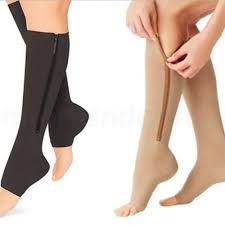
Zip socks are the long-awaited solution to compression socks that are notoriously hard to put on and take off.
Like regular compression socks, they guarantee comfortable compression and support. The zipper ensures that they can easily be applied or removed at any time.
They are available with both convenient external zippers and discreet internal zippers. Most zippered compression socks feature a loop at the top of the zipper that is easy to grab for those with arthritis.
Compression therapy helps to improve circulation in those with diabetes and other venous disorders that cause tingling, numbness, and coldness.
The pressure prevents blood from pooling in the lower extremities. It can also help with the prevention and treatment of swelling and deep vein thrombosis.
Even people who have to sit for long periods of time on airplanes can benefit from compression therapy and zip socks specifically.
Benefits of Wearing Zippered Compression Socks
The unique design of zip socks offers a lot of benefits, including.
Convenience: Zippered compression socks are very easy to put on. All you have to do is unzip the sock, insert your foot, pull up the sock, and zip it back up.
Breathability: Many zip socks feature an open-toe design, which allows for better air circulation. This along with the lighter material of the socks will help to increase comfort and breathability.
Many people experience sweaty, smelly feet when using traditional compression socks, and they need to wash and change them quite frequently.
This is especially true for people who live in hot climates and those who work out frequently.
Zip socks can save you time and energy because they are designed to prevent moisture and odor buildup.
Quick Recovery and Long-Term Wear: Zippered compression socks offer graduated compression, which helps with recovery after a stressful workout. All you need to do is wear the socks before, during, and for some hours after the workout. This helps to prevent the buildup of lactic acid, the main cause of post-workout soreness.
Portability: Another great thing about zip socks is their small size and portability. They are so easy to carry around since you can easily fold them up, pop them into your bag or purse, or hang them by your bedpost. They do not make your luggage any heavier, so it is easy to travel with them.
Even when you have a pair on, it’s easy to bring along extras so you never have to worry about wearing socks that are dirty or wet.
Just make sure you do not pack them with sharp objects such as pens, pins, or razor blades that can cause tears.
Who Are Zip Socks Made For?
Zip socks really do have a genius design. Since the zipper is located either on the inside or outside of the socks, you can easily open the socks and insert your foot.
As soon as you zip the sock back up, you will get the compression and support you need. When, at the end of the day, you need to take off the socks, all you need to do is unzip them and slide them off.
While there are few who would not benefit in one way or the other from wearing a compression sock with a zipper, there are some people for whom compression is specifically recommended or prescribed.
These set of people include:
- People who suffer from circulation problems such as deep vein thrombosis (DVT) and diabetes
- People who are bedridden
- People who have to stand for a very long time
- Amateur and elite athletes
- Pregnant women
- People who are having trouble wearing regular compression socks
Why Do You Need a Zip Sock?
There are several reasons you need zip socks, including:
Improving Circulation: There are some conditions that do not allow proper blood to flow in the legs. Some of these conditions include varicose veins, peripheral arterial disease (PAD), and peripheral vascular disease (PVD), among others.
Wearing zip socks according to the size and pressure recommended for your condition will help you to enjoy reduced pain and efficient blood delivery to the affected areas of your body.
Before buying the socks, try them on if possible. Ensure they feel snug, especially around the affected areas.
Also, they should not feel too tight, however, as that will actually impede your blood circulation.
Relief from Edema: Many people experience edema or swelling in their legs. Diabetic patients, in particular, are prone to edema and can suffer from it for years. The best way to get comfort or relief from edema is by using zip socks.
These socks will help to alleviate the pain that stems from the swollen tissues. The socks will also help to boost circulation in the affected area, which hastens healing.
Experts recommend that people suffering from edema use zippered compression socks with a compression range of 15 to 20 mmHg.
Pain Relief: There are a lot of conditions that can cause pain in the legs, including muscle weakness and fatigue, muscle spasms, long-distance running, and sprains.
Athletes also wear zippered compression socks to provide extra support to their calves and thighs. These socks will help to quickly eliminate pain and prevent future soreness.
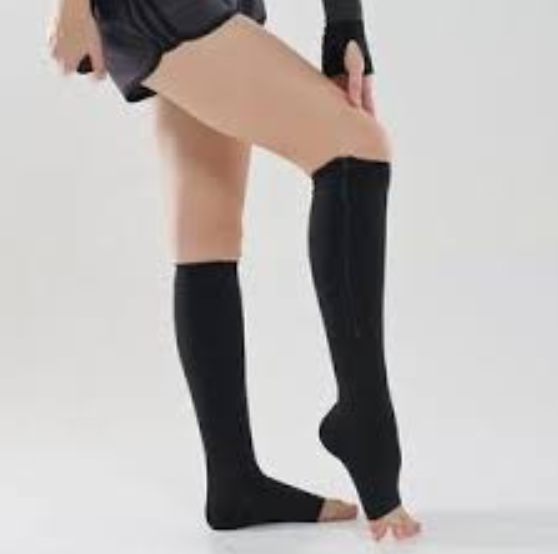
Like regular compression gear, zippered compression socks are available in a variety of lengths that provide support to the ankles, calves, shins, knees, hamstrings, and even the thighs.
Criteria for Choosing the Best Zip Sock: Zip socks, unlike most compression socks, come with a zipper feature.
The zipper makes life easier for a lot of people, especially those with arthritis and weak hands.
Also, people with sensitive skin may find zippered compression socks easier to wear than normal compression gear.
Make sure to check out the following tips before you go out in search of your own awesome pair of zip socks
Durability
Although compression socks are quite expensive, they are usually a good investment. The socks’ durability strongly influences their price.
More durable socks will cost more than lower-quality ones.
Your zippered compression socks will need to be able to withstand day-to-day wear without showing signs of damage. This means they need to be made of sturdy materials, such as Lycra, polyester, and nylon.
You also need to ensure that your zippered compression socks have a good quality zipper that is firmly sewn into the sock as they are not easily replaced.
In addition, ensure that the zipper does not dig into the skin and cause irritation or blisters.
Good stitching determines quality. Reinforced stitching in the toe and heel will prevent holes, which will make your investment last longer.
Compression Rate
Compression socks are available at different compression levels. Most manufacturers make socks in four to five compression levels.
Like blood pressure, the sock pressure is measured in millimeters of mercury (mmHg), and the pressure rating determines the tightness of the sock.
A lighter compression level will feel like a soft hug, while a stronger compression level is more like a titan grip.
Remember that the pressure in zippered compression socks is strongest at the ankle and weakest at the top of the sock.
You do not need compression that is higher than 15mmHg if you do not have any major health issues. This lower level is perfect for fighting off fatigue, minor swelling, and minor circulation problems.
Compression levels ranging from 15 to 20 mmHg are great for pregnant women, travelers, and people suffering from minor deep vein thrombosis (DVT).
Tighter compression levels in the range of 20 to 40 mmHg help to stave off more serious circulation issues.
Super strong compression levels above 40mmHg are mainly for patients who are recovering from surgery or experiencing severe medical issues.
While lower levels of compression are available over-the-counter, higher levels require a doctor’s prescription.
Fit
The fit of a compression sock is one of the most important factors to consider. The sock needs to apply a specific amount of pressure at specific parts of the leg, so an improper fit will not deliver the same benefits.
Make sure that you take your measurements and invest in a sock that is neither too loose nor too tight.
Length

Most of the time, doctors and physical therapists prescribe compression socks based on their assessment of the patient’s condition and the patient’s tolerance.
The length of zip socks that is best for you depends on whether or not:
- You will sleep with the sock on
- Wear the sock all-day
- Exercise in the sock
- Travel in the socks
Ankle-High Zip Socks: Ankle-high zip socks are ideal for those with sensitive feet, diabetics, athletes, and people who spend a lot of hours working on their feet.
They offer a firm compression zone for swaddling the Achilles tendon.
The upward compression of ankle-high zippered compression socks will help to relieve the stress placed on the Plantar fascia, the main cause of heel pain.
Athletes and other sports enthusiasts can run and jump in these socks without feeling foot pain, even after an intense workout.
Knee-High Zip Socks: Knee-high zip socks are the go-to length for most people who need compression socks. The height is perfect for swelling issues, warmth, and clot prevention.
Knee-high zip socks are often prescribed for people suffering from bone and joint problems. If, however, you feel the knee-high length isn’t right after giving it a try, you can always try a different length.
Thigh-High Zip Socks: Thigh-high socks are usually recommended for athletes.
They can also help with a wide variety of ailments, including varicose veins, swelling, muscle fatigue, deep vein thrombosis, and lymphedema.
Those who wear them need to take all of their leg measurements to ensure they get the right size sock in order to maximize benefits.
They also need to talk to their doctor about choosing the right compression level for their needs.
Care
Both traditional and zippered compression socks need to be washed regularly to keep bacteria and microbes at bay. Regular washing also ensures your socks do not stink, especially when they get soaked with water or sweat.
Fortunately, washing your zip socks is easy. Since strong detergents and violent wash cycles can damage socks, it is a good idea to hand-wash them for best results.
It is also important to remember not to place your zip socks in a dryer. Air dry them, ensuring they are not in direct sunlight.
Ease of Wearing the Socks
You can’t reap the benefits of compression socks if you find it challenging to put them on and take them off. Fortunately, the zipper feature of some compression socks provides an easy solution for this problem.
There is no need to follow a litany of difficult steps to wear them properly.
With zip socks, all you have to do is unzip the sock, pull it over your foot and calf, then zip the sock back up. It really is that simple! If you are having difficulty, it may mean that you need to double-check your sizing.
Effectiveness
Many people worry that the zipper will affect the quality of the compression sock. Fortunately, however, they provide the same compression as a regular sock. They provide all of the benefits without the application drawback.
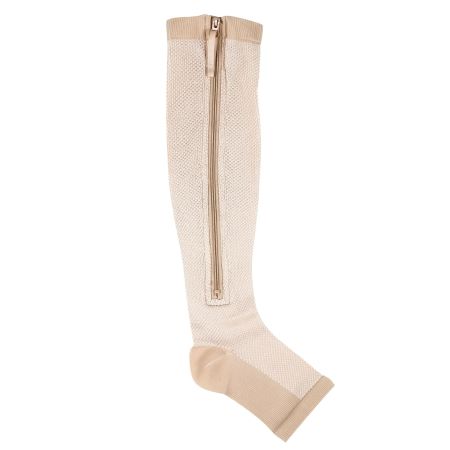
Like regular compression socks, zippered compression socks combat circulation issues such as varicose veins, DVT, spider veins, and clotting. They can also help prevent and relieve itching, cramping, burning, and swelling.
Zippered compression socks are also helpful for those with milder problems, including those who spend a lot of time on their feet or at the gym. Wearing them can help to lessen general muscle soreness and fatigue.
Materials
Features such as durability, fit, compression level, and even washability are dependent on the material of the compression sock. Typically, they are made from a blend of nylon, spandex, and/or polyester.
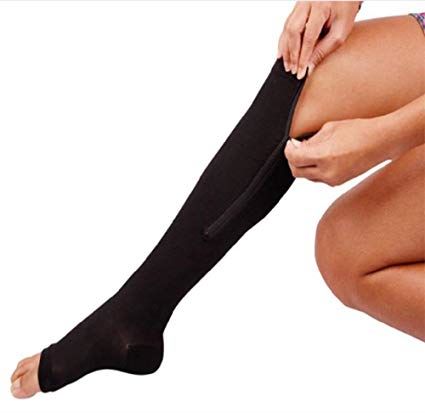
Nylon is used because it is both stretchy and breathable. Materials such as Lycra and spandex are added to the sock to provide additional stretch.
Polyester is added because it is lightweight, thin, and comes in a variety of colors.
Zippers are generally made of nylon, plastic, or metal. While metal zippers are heavier and more durable than plastic ones, they are less flexible.
One broken tooth on a metal zipper means that the whole thing needs to be replaced. Nylon and plastic zippers, on the other hand, can still function with a few missing teeth.
In a nutshell, ensure the materials of your compression gear are durable so they will last longer.
Special Features
Zip socks come with a pillowed sole that provides more cushioning, reduces blistering, prevents callus buildup, allows you to walk comfortably for miles, and maintains your leg health.
Make sure your chosen sock is also padded in the foot, heel, and toe areas. This will help to increase comfort and reduce friction. Some socks also have a compressive mid-foot feature that prevents the bunching associated with regular socks.
Another special feature to consider is channeled, smooth, flat toe seams, which reduce irritation.
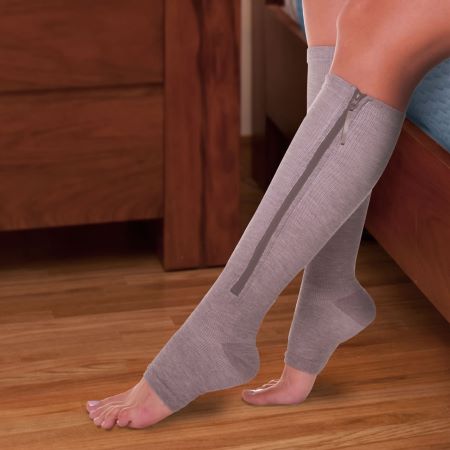
Some compression socks are also finished with antimicrobial and moisture-wicking acrylic fibers.
These prevent the growth of bacteria and fungi for those who live in humid environments. They also prevent odors by ensure the socks and feet stay dry all day.
In addition, these finishing fibers help to keep your feet cool while reducing the chances of fungal infections.
Why Do Most People Prefer Short Length Zip Socks? The most common length of zip socks is ankle-high. Usually, this length is recommended for people with lower leg problems.
Although some people initially set out for higher socks, they end up getting knee-high or ankle-high zip socks because they are more common.
When should you try shorter socks?
- If, after wearing your knee-high socks, you notice that the top band is uncomfortable and often digs into the bend of your knee
- If the longer sock is prone to wrinkles
- If you find yourself folding down the longer sock, which can cause various circulation problems.
How To Find Your Perfect Zip Sock Size
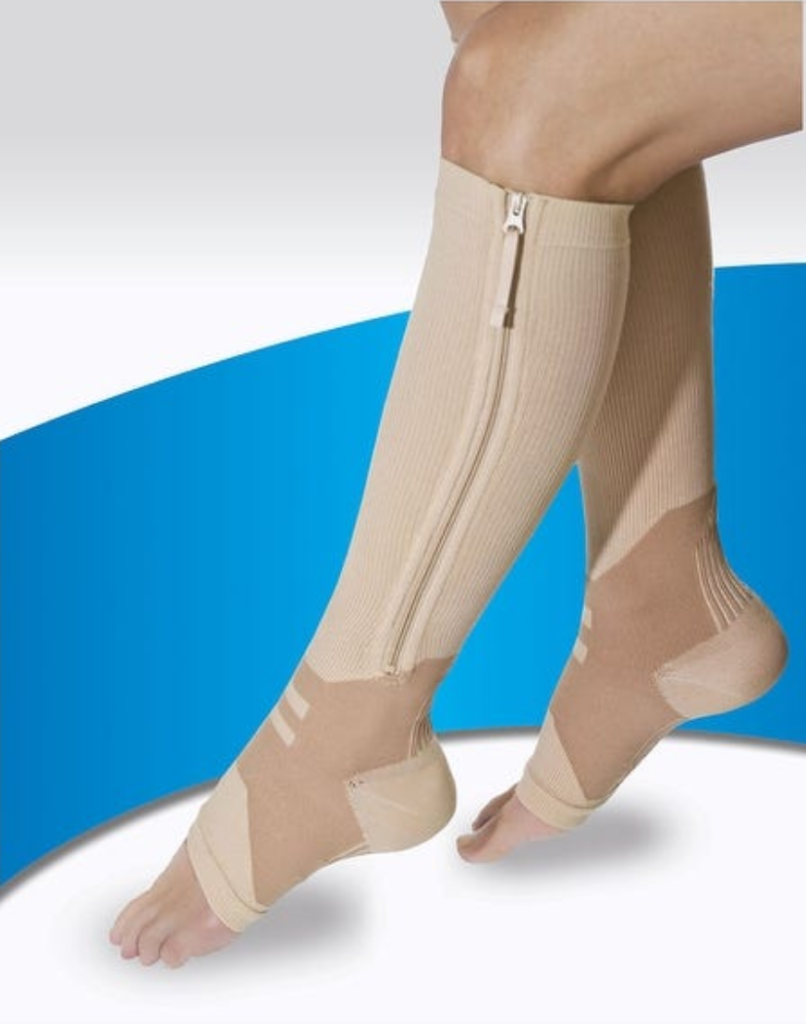
Measuring your leg to get the right size for your zippered compression socks is actually quite easy. All you really need is a measuring tape.
Most brands have a unique sizing chart, but all of the sizing charts use the same basic measurements.
- Take your measurements as soon as you wake up. Leg swelling is at a minimum first thing in the morning.
- Measure directly on the skin, not over clothing.
- When taking measurements, your foot should be flat on the floor and your knee should be bent at a right angle.
- Use a cloth measuring tape for accuracy. Measurements should be taken with the tape snug on the skin, but not pulled tight.
- Length measurements are taken from the ground up.
- Take all of your measurements at once.
Here are some instructions on getting the right measurement for your knee-high, thigh-high, or waist-high socks.
Ankle-High Measurements: This measurement covers the measurements you will need for ankle-high socks. Ankle measurement is actually important for all sock lengths because graduated compression starts at the ankle.
Note that in some cases, the ankle measurement for the right leg may be different from the ankle measurement for the left leg.
To get your ankle circumference measurement, wrap your tape measure around the narrowest part of the ankle, right above the ankle bone.
Knee-High Measurements: If you are getting knee-high (or longer) socks, you will need accurate calf measurements. These ensure that the sock will not be too tight or too loose.
This is important because a tight sock will bind and roll while a loose sock will slide down the leg.
You will also need to measure your lower leg length. Most socks are available in at least two different lengths.
A sock that is too short will not properly hold your calf, while a sock that is too long will roll any time you bend your knee.
Calf Circumference: Wrap the tape measure around the widest part of your calf.
Calf Length: Measure from the floor to the bend of the knee.
Thigh-High Measurements: You will need to make sure you take additional measurements for thigh-high compression socks to ensure they are not too tight or too loose.
Accurate measurements will help you get the best results. Pantyhose style compression gear will also require you to measure your hip circumference.
Keep in mind that compression socks are designed to be stretchy. If you overstretch them, however, it can cause them to fit too tightly. This will make you uncomfortable and provide inadequate compression.
Thigh Circumference: Wrap your tape measure around the widest part of your thigh.
Thigh-Length: Measure the distance from the floor to the bottom of your buttocks.
Hip Circumference (For Pantyhose): Measure the circumference of the widest part of your hips.
Conclusion
Normally, compression socks are quite hard to put on and take off, but there is no need to buy fancy gear like donning aids or special gloves to help. Instead, consider using zippered compression socks if you have difficulty.
They are a fantastic solution to this all-too-common problem.
